Oxford University Press's Blog, page 647
July 4, 2015
The meanings behind the anthems of Fourth of July
On the Fourth of July, Americans will celebrate Independence Day at picnics, concerts, fireworks displays, and gatherings of many kinds, and they almost always sing. “America the Beautiful” will be popular, and so will “Our County, ’Tis of Thee,” and of course the national anthem, “Star-Spangled Banner” (despite its notoriously unsingable tune). The words are so familiar that, really, no one pays attention to their meaning. But read them closely and be surprised how the lyrics describe the meaning of America in three very different ways.
“America the Beautiful” details a remarkable vision of America. Each of the four stanzas starts with “O beautiful.” The first stanza praises the beauty and abundance of the land — “spacious skies,” “amber waves of grain,” “purple mountain majesties,” “fruited plain,” and “shining seas.” All four stanzas appeal to God, asking for grace, brotherhood, perfection, and nobleness. Uniquely among the three songs, “America the Beautiful” invokes a social and moral vision for America. The second stanza lauds New England’s religious founders, the Pilgrims, for beating “a thoroughfare for freedom” “across the wilderness.” However, freedom does not imply license if God will “confirm thy soul in self-control, / Thy liberty in law.” Stanza three praises the self-sacrificing soldiers of the “liberating strife” of the Civil War and asks God to make the nation’s wealth into a “gain divine” and by implication not simply for the sake of greed. The last stanza describes a “patriot dream” of the future: a beautiful America full of gleaming alabaster-white cities “undimmed by human tears.”
Katharine Lee Bates wrote “America the Beautiful” in 1893 after an inspirational climb to the top of Pike’s Peak in Colorado. Daughter of a Massachusetts Congregational minister, she published it in The Congregationalist magazine, appropriate for such a deeply religious (and, incidentally, very Congregational) poem. Congregationalists were descendants of the Puritans of New England. Puritans sought godly, orderly communities and built those classic New England towns with their white church spires rising over town greens amidst green and plentiful landscapes. Puritan ministers preached self-control and Puritan laws limited liberty for the common good and for God’s glory. Congregationalists like Bates still deeply held to those values. “America the Beautiful” is Puritan and Congregational from beginning to end.
“My Country, ’Tis of Thee,” another religious patriotic song, addresses God in the first line and again in the last stanza. All four stanzas glorify freedom and liberty. God is “author of liberty” and unlike “America” the poem acknowledges no limits on freedom. The land and its beauty are not the focus as they are in “America,” although freedom rings from mountainsides and “thy rocks and rills, / Thy woods and templed hills” call to mind New England’s white-steepled villages nestled amidst a rolling forested landscape. Like “America,” “My Country, ’Tis of Thee” inserts religious filial piety in lines about “Land where my fathers died, / Land of the pilgrims’ pride” and “Our fathers’ God.”
Samuel Francis Smith wrote “My Country, ’Tis of Thee” in 1831 as a student at Andover Theological Seminary in Massachusetts. Smith was a Baptist, unlike Congregationalist Bates, which makes a huge difference in the lyrics’ sentiment. Baptists were rebels against the Puritan/Congregational New England order, with thoroughly individualistic attitudes about society and religion. Government, society, and the church must just leave people free to act according to conscience. A godly society would come when each individual accepted Jesus. “My Country, ’Tis of Thee” is a Baptist anthem to a country of the free individual.
“Star-Spangled Banner” is a war hymn of patriotic emotions stirred at the sight of the nation’s flag still flying at dawn after an all-night bombardment. The first three of its four stanzas describe scenes of war. Bombs burst and rockets glare. “The foe’s haughty host” replete with “hirelings” and “slaves” washes the soil clean with blood in “the terror of flight, or the gloom of the grave.” The last stanza finally mentions God, who “hath made and preserved” the nation (by war, perhaps?). No stanza actually says anything about the nation itself, whether the land, the cities, or the people, except that they are free and brave.
Francis Scott Key wrote “Star-Spangled Banner” after he witnessed the British attack Fort McHenry in Maryland in 1814. Key was a Maryland lawyer and slaveowner who later defended slavery against attacks by abolitionists. Southerners rarely expressed much of a social vision and as slaveowners certainly looked upon government interference with their freedom of action as a threat to their interests. Unsurprisingly, “Star-Spangled Banner” lacks any vision (or even mention) of American society. For four verses it sings of pride in free Americans, so brave in war, and in their “gallantly streaming” flag.
These three patriotic songs give Americans three ways to sing the meaning of America for this Independence Day, July 4, 2015.
Image credit: Public domain via Wikimedia Commons.
The post The meanings behind the anthems of Fourth of July appeared first on OUPblog.

What marriage (equality) means
Like many, I’m still digesting the Supreme Court’s Obergefell decision—not just its text, but its personal and social significance. When I wrote Debating Same-Sex Marriage with Maggie Gallagher, only a handful of states in America permitted same-sex couples to marry. In the three years since, that handful grew to dozens; last Friday’s decision grows it to all 50 states.
One striking thing about the decision itself is the importance of the definitional question: What is marriage?
If the state prohibits same-sex couples from marrying, does it thereby interfere with their liberty, as the majority argues, or does it simply decline to grant them certain benefits? If the latter, is it treating them unequally—and thus violating the Equal Protection clause of the 14th Amendment—by privileging certain citizens without sufficient reason for the distinction? The answer depends on what marriage is. If marriage by definition requires (at least) one man and one woman, then same-sex “marriage” is impossible by definition, and one does not treat people unfairly by denying them something impossible.
That definitional argument underlies all four dissents, sometimes only implicitly, and it was a significant part of the debate between Gallagher and me. But even if Gallagher and other social conservatives are correct to believe in a “natural,” pre-political, essentially heterosexual union called marriage, that wouldn’t resolve the disagreement in Obergefell. That’s because the question remains whether the state-granted legal privileges and benefits currently associated with civil marriage must be reserved only for those in so-called “natural” marriages, thus understood. The Court has said no, rightly observing that to doing so is an affront to gay people’s liberty and equality. As I wrote in Debating Same-Sex Marriage:
 “SCOTUS Marriage Equality 2015″, by Ted Eytan. CC-BY-SA-2.0 via Flickr
“SCOTUS Marriage Equality 2015″, by Ted Eytan. CC-BY-SA-2.0 via Flickr“The Fourteenth Amendment of the U.S. Constitution guarantees the “equal protection of the laws.” By itself, I don’t believe that this guarantee automatically gives anyone—gay or straight— the right to marry, at least not in the sense of a particular kind of state recognition. As Martha Nussbaum (among others) has argued, there are various ways in which the state might consistently and fairly treat its citizens, including getting out of the marriage business altogether. But once the law state provides marriage as an option for different-sex partners, even if they cannot or choose not to have children; even if they are elderly; even if they are divorced; even if they are incapable of coitus, and thus what the new-natural-law theorists consider “real marriage”—once the law state provides marriage in all these diverse cases and more, but then denies it to same-sex couples, it is treating citizens unequally (89-90).”
Philosophers, theologians, and others will continue to debate what marriage really is, as they should. Obergefell doesn’t change that. What it does do is to settle an important constitutional question, and thereby to extend civil marriage rights to many people—like me—who have long hoped for them.
Featured image credit: “Supreme Court Ruling Celebration”, by Russell Mondy. CC-BY-NC-2.0 via Flickr.
The post What marriage (equality) means appeared first on OUPblog.

July 3, 2015
Alice down the microscope
Tomorrow Oxford will celebrate Alice’s Day, with mass lobster quadrilles, artwork and performances, croquet, talks, and teapot cocktails, and exhibitions of photographic and scientific equipment. The diverse ways in which Alice and her Wonderland are remembered and recast reveal how both heroine and story continue to speak to many different kinds of audiences, 150 years since Lewis Carroll’s book was first published. The 2015 events are just the latest in a series of commemorations: over the decades Alice’s Adventures have proved ripe for reinterpretation and reworking. Especially, it seems, by members of the scientific community.
Indeed, one text, Alice in Electronland, published in July 1943 by American Scientist, purported to be a hitherto unknown ‘original manuscript of Lewis Carroll’. From ‘curiouser and curiouser’ changes in scale, to philosophical conversations with ‘strange creatures’, and even a revamped Walrus and Carpenter who bemoaned the current state of academic research funding, Alice in Electronland took familiar elements of Carroll’s writings and reworked them with a scientific slant. As in the original book, novel perspectives on everyday habits and objects were encouraged; and well-known rhymes just seemed to come out differently:
“The time has come,’ the Walrus said, ‘to talk of applications,
The uses of the microscope in our investigations,
To take a peek at things that were our former speculations.”
The article, it transpired, originated from Stanford University, and rather than being an undiscovered Dodgson dossier, was rather a sophomoric caper by electron microscopists. In its amusing juxtaposition of a playful narrative form with calls for university reform, as well as scientific content, the text paid tribute not only to Alice, but also to ways in which her author combined sense and nonsense, logic and play, imagination and inventiveness, in his range of other publications on anything from Euclidean drama to the new Christ Church belfry.
Students on the other side of the Atlantic had also looked back to Alice when making sense of their scientific work: Alice down the microscope in the Cambridge student magazine Brighter Biochemistry. As in Wonderland, the protagonist embarked on a journey into another world where its protagonist encountered novel organisms, engaged in dances, and was even put on trial. The short journalistic tale from 1927 was presented as a vision that Alice experienced after availing herself perhaps too liberally of the ‘audit ale’ at lunch at her Cambridge college. Bored with ‘looking down the microscope trying to see all the things her Professor had told her she ought to see’, and finding only ‘vaseline and air bubbles’ rather than ‘motile bacteria’, Alice expressed doubt they were ‘there at all’, and wished she ‘could go down and see’. Her wish was granted, and ‘she found her way through the various lenses of her microscope’ and grew ‘very small (3 x 1.5µ)’.
 Down the Microscope and what Alice found there. Biochemical Society, December 1927 by the Wellcome Library, London. CC-BY-4.0 via Wikimedia Commons.
Down the Microscope and what Alice found there. Biochemical Society, December 1927 by the Wellcome Library, London. CC-BY-4.0 via Wikimedia Commons.Adopting the tone of a Victorian professor, reminiscent of Carroll himself, the narrator mixed both technical detail and avuncular hectoring to describe the microscopic realm. Just as in the original story, Alice encounters an inhabitant of the strange world she found herself transported into, only rather than dodos and caterpillars this time it was ‘a sausage-shaped person somewhat larger than herself, whose whip-like tail was still twisted round her legs’. This ‘person’ introduced himself as ‘Bac. Pyocyaneus’, or ‘“Pyo” to real friends’. An illustration paying homage to John Tenniel’s famous depiction showed Alice and a hat-wielding Pyo together, as he proceeded to take her on a tour of the environs. This served to satirize the educational institutions themselves, for instance, when the duo found themselves in ‘a large lecture theatre, where an active little coccus was delivering a lecture on “Housing Conditions in the Human Body”’. The lecture discussed the ‘clearance of the slum areas in the appendix and large intestine’, and discussed the potential for further ‘colonization’ of the liver, brain, and lungs: in these ways, it set up contemporary debates over hygiene, class, and empire. Alice also watched live cell division in action, what her bacterial companion called ‘the final Sublimation of Family Life’; as an evidently ‘motile’ bacterium (with, furthermore, a ‘pretty arrangement of flagella’), she was then invited to dance, and in the ‘pitiable efforts of non-motile forms . . . recognised at once the Bacterial Origin of the Charleston’. Other familiar scenarios from the Victorian originals were recast, for instance when Alice is put on trial, accused of being a pathogenic member of the Human Race and having committed treason against ‘the Bacterial State’. ‘In vain Alice pleaded’, the article went on, ‘that she was only a poor student incapable of writing scientific articles.’
These two articles are just one small part of the continuing appeal of Alice, and how the original story has proved so inspirational for so many. By the mid-twentieth century the book was not only a familiar means of making in-jokes about a particular scientific subject, but also a way of thinking more generally about the challenges posed by new instruments, techniques, institutions and discoveries. Rabbit-holes and looking-glasses may have their place, but the surest way to Wonderland, these texts seem to show, was to be found in practising the sciences.
The post Alice down the microscope appeared first on OUPblog.

City University London triumph at OUP BPP Moot 2015
Congratulations to City University’s Charlotte Bellamy and Raphael Gray, who gave an exceptionally polished and professional performance and won the Oxford University Press (OUP) and BPP National Mooting Competition 2014-2015 on 25 June 2015.
His Honour Judge Charles Gratwicke of Chelmsford Crown Court presided over the final and praised the hard work and depth of knowledge the students demonstrated. Indeed, it was the the closest final in years.
The fictitious moot problem was a criminal division appeal, focussing on an incidence of religious circumcision which led to a conviction for actual bodily harm for the priest who performed the procedure. The topical exercise enabled all the finalists to shine as advocates, and all the moot problems for this year’s competition were written by Rory Clarke and Ros Earis. (Rory was part of the winning City University London team from 2010-2011.)
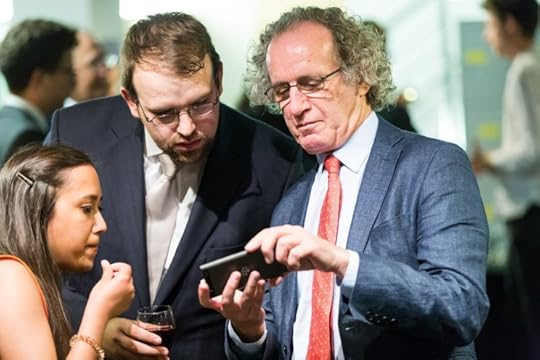
OUP BPP Moot
Attendees mingle at the drinks reception

OUP BPP Moot
Queen’s University Belfast finalists Sasha Conlon and Elspeth Venn talk over some last-minute notes.
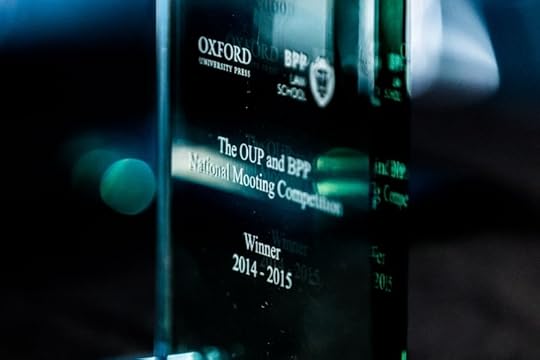
OUP BPP Moot
The OUP & BPP National Mooting Competition 2014/2015 winner’s trophy.

OUP BPP Moot
The OUP & BPP National Mooting Competition 2014/2015 programme.
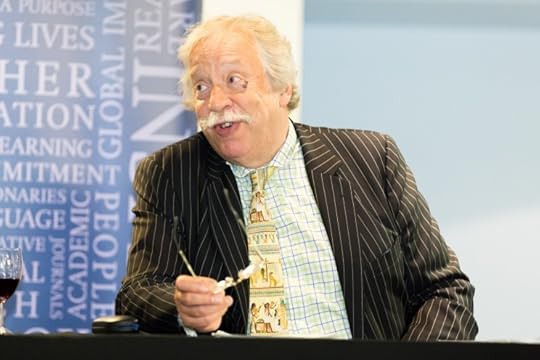
OUP BPP Moot
His Honour Judge Charles Gratwicke presided over the final once again.
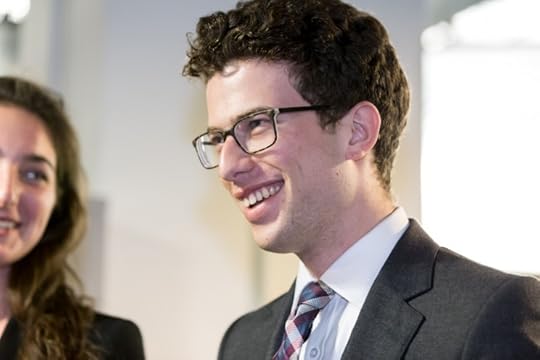
OUP BPP Moot
Raphael Gray of City University London is all smiles upon being announced as the winning team.
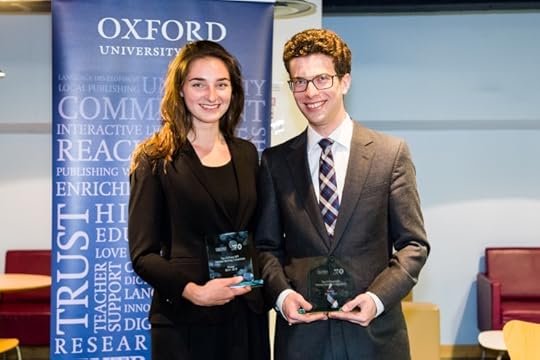
OUP BPP Moot
Charlotte Bellamy and Raphael Gray: The OUP & BPP National Mooting Competition 2014/2015 champions.
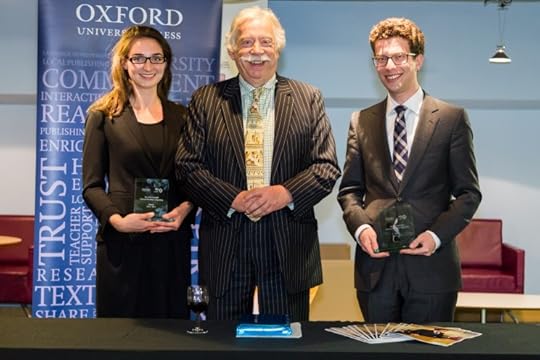
OUP BPP Moot
Charlotte Bellamy and Raphael Gray with Judge Gratwicke and their winner’s trophies.
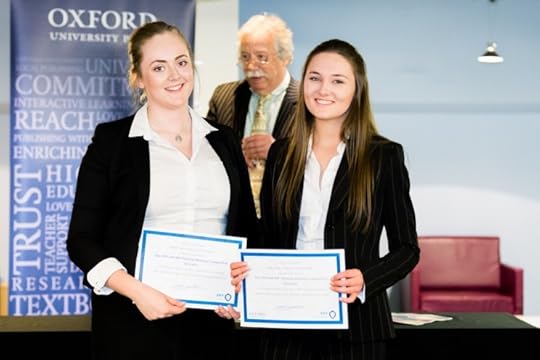
OUP BPP Moot
Elspeth Venn and Sasha Conlon of Queen’s University Belfast finished as runner’s up.
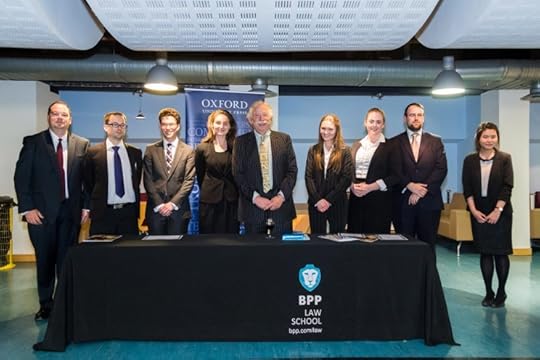
OUP BPP Moot
The finalists of the OUP & BPP Mooting Competition 2014/2015 with Judge Gratwicke
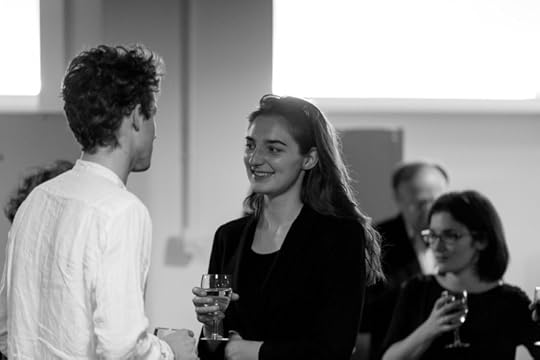
OUP BPP Moot
Senior counsel from City University London, Charlotte Bellamy, awaits the result.

OUP BPP Moot
Supporters share a laugh at the post-mooting reception.
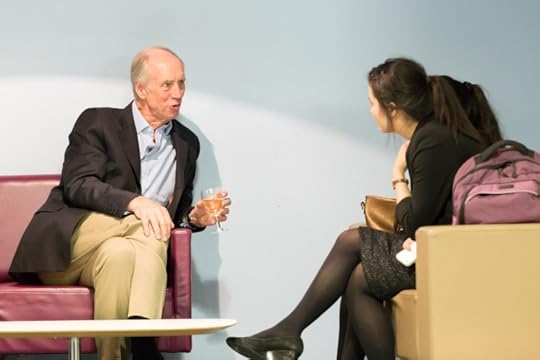
OUP BPP Moot
Discussion of the final continues over drinks.
Finalists included Charlotte Bellamy and Raphael from City University; Gray Peter Savory and Joseph Thomas from the Open University; David Rose and Chyi Sean Chung from the University of Greenwich; and Sasha Conlon and Elspeth Venn from Queen’s University Belfast.
Charlotte Bellamy and Raphael Gray received a certificate, trophy, and £750 each. Elspeth Venn and Sasha Conlon, both first year students, finished second and share £700 between them. The other finalists received £150 of OUP books each. Of course the competitors didn’t do this alone — the judges, clerks, and mooting coordinators helped them on their way.
All images courtesy of Oxford University Press.
The post City University London triumph at OUP BPP Moot 2015 appeared first on OUPblog.

The history of American women [quiz]
Over the past several decades, few fields of American history have grown as dramatically as women’s history. Today, courses in women’s history are standard in most colleges and universities, and historians regularly produce scholarship on women and gender. In 1981, historian Gerda Lerner provocatively challenged, “always ask what did the women do while the men were doing what the textbook tells us was important.”
In her book American Women’s History: A Very Short Introduction, author Susan Ware responds to Lerner’s statement, discussing the achievements of women throughout American history. How familiar are you with the women who shaped America as we know it today? How much do you know about the history of American women?
Get Started!
Your Score:
Your Ranking:
Image Credit: “Pocahontas saves the life of Capt. John Smith.” by United States Library of Congress’s Prints and Photographs division. Public Domain via Wikimedia Commons.
The post The history of American women [quiz] appeared first on OUPblog.

July 2, 2015
Entertaining Judgment – Episode 24 – The Oxford Comment
What truly awaits us on the ‘other side?’ From heaven to hell (and everything in between), our conceptions of the afterlife are more likely to be shaped by shows like The Walking Dead than biblical scripture. Speculation about death, it seems, has permeated every aspect of our everyday experience, manifesting itself in lyrics, paintings, and works of literature.
But to what extent does popular culture shape our imagination of the afterlife? In this month’s episode, Alyssa Bender, an Assistant Marketing Manager, and Carolyn Napolitano, a Marketing Associate, sat down with Greg Garrett in the New York office to discuss the intersection of the cultural and the theological in modern-day life.
Image Credit: “Hats and Hell” by Thomas Hawk. CC BY NC 2.0 via Flickr.
The post Entertaining Judgment – Episode 24 – The Oxford Comment appeared first on OUPblog.


Going sour: sweet words in slang
Through time, we use, reuse, and recycle words to our liking and even make up completely new words, much to some people’s chagrin. Even words about sweetness—sugar, honey, sweetie—aren’t exempt; in a number of cases, they have been re-spun and re-purposed to fit the uses of everyday communication. In the following excerpt, Jonathon Green, an expert lexicographer and contributor to The Oxford Companion to Sugar and Sweets, gives us the rundown of the sweet terms and phrases that have been re-imagined and incorporated into slang.
Slang—mocking, sneering, casting a jaundiced eye on the world’s proprieties—is by its nature sour. It finds approval hard, congratulation challenging, and affection almost impossible. Yet even if slang’s oldest meaning of “sugar” is money, and the second oldest a euphemism for the most common term for defecation, slang, for all its skepticism, cannot resist the tempting possibilities of “sweet.” It has no word for “love,” but someone can “be sweet on” someone else, and the trope “good enough to eat” characterizes a wide range of human love-objects. But slang has its limits. The presence of sweetness—whether the term itself; semantic equivalents such as “honey” or “sugar”; specifics such as “cake,” “toffee,” “candy,” or “lollipop”; or a variety of brand names such as M&M’s (drugs in pill form)—is regularly turned on its head in a wide range of negative definitions. In slang’s upside-down, inside-out, tweaked, and twisted world, even sweet can turn sour.
Let us begin, then, with “sweet” itself.
Judged by slang’s mainly concrete lexis, the word “sweet” manages quite a few abstractions. There is the ironic sweet: a “sweet mess,” “take your own sweet time”; there is the approving sweet, applicable to people, objects, actions, and events. There is sweet in human terms, which can mean gullible, but also dexterous and expert; in criminal terms, it can mean devoid of suspicion, as well as simple and lucrative (when describing a crime as safe). To “be sweet” is to be amenable; this usually occurs as “keep/have someone sweet”—to keep someone well disposed toward oneself, especially by complaisance or bribery. Given the traditional equation of little girls with “sugar and spice,” it can also imply effeminacy when used of a male, thus yielding compounds such as “sweet kid,” “sweet girl,” or “sweetmeat”—prison terminology for a younger prisoner who joins up with an older man. (Sweet, when referring to real females is, of course, standard.) As noted earlier, to be “sweet on” is to be in love with or infatuated by, though it can also mean nagging, pestering and insistent, free of relationships, and simply satisfied or happy. Australia’s “she’s sweet” or “she’ll be sweet” means everything is satisfactory, as does “she’s be apples” or “she’ll be apples.” That which is easy or pleasurable can be “sweet as a nut,” “sweet as honey,” or “sweet as a lolly.”
Sweet can act as an intensifier: “sweet (bleeding) Jesus!”, “sweet Christ!”, and others. It can refer to the beloved, the “sweet papa” or “sweet mama” (though the inference is of financial transaction and the primary synonym remains “sugar daddy”); thus it can also modify the world of commercial sex, giving the “sweet mack” or “Sweet Willie,” a (relatively) gentle pander. The pimp is also a “sweetman,” although the word can cover a less compromised lover—what makes him sweet are the gifts he brings, and perhaps his “sweet-mouth” (his verbal skills).
 When you need a ‘blond and sweet’ coffee. Photo by Justin Leibow. CC- 1.0 via Unsplash.
When you need a ‘blond and sweet’ coffee. Photo by Justin Leibow. CC- 1.0 via Unsplash.In standard usage, to “sweeten” is to adulterate with sugar; its slang definitions include to bribe, to flatter, or to mollify (typically a con man’s anxious victim). The trickster is the “sweetener,” a term that can also mean a bribe; a word of encouragement, or a threat of force; the lips; and, slang’s male viewpoint aforethought, the penis. Sometimes sweet can be taken literally, as in the short-order jargon’s “blonde and sweet” (coffee with cream and sugar). “Sweetness and light” meaning whiskey, suggests a positive image of the liquor’s effects (not exactly what Matthew Arnold was thinking of in Culture and Anarchy).
What works for sweet also works for sugar, typically in its use for a range of wealthy lovers—“sugar daddy,” “sugar papa,” “sugar-pops,” “sugar mama,” or “sugar mummy”—although this latter should not be confused with the “yummy mummy,” a British confection suggesting that sexiness need not terminate with maternity, and which in turn is synonymized by pornography’s blunt acronym, the MILF. “Yummy” can also be used of a nubile teenager and is kin to “yum-yum,” used around 1880 for sex, and for a female who might permit it.
“Sugar” picks up on the monetary associations of “sweeten,” to mean a bonus or a bribe, and the verb form means to bribe or to present a fake image. A “sugar-bag” accepts such gifts, though the second-rate materials used for such containers have led to the meaning “second-rate” for the word’s adjectival form. Inferiority also accompanies the compound “tea-and-sugar,” usually joined to a bandit or burglar, both petty thieves. It is also—though here the link is only assonant—a euphemism for “shit” (either as excrement or used as an exclamation), though, like shit, sugar can also mean money. The terms “big sugar” and “heavy sugar” refer to substantial sums of money, while a “heavy sugar daddy” or “heavy sugar papa” is a woman’s generous or exploitable older lover. Men turn the tables with “sugar basin,” the vagina, into which they deposit “sugar,” or semen. The “sugar-bush” is the pubic hair, and the “sugarstick,” inevitably, the penis. The nineteenth-century exclamation “sugar, cock your legs and cry” signifies triumph or delight among members of the underworld and is accompanied by standing on one leg, cocking up the other, and shouting “Sugar!” Perhaps it equates with modernity’s approving “sweet!”
Like sugar, the term “candy” is far more common in the United States than elsewhere. The word can mean something admirable or desirable. It can refer to money or someone seen as “sweet,” with or without sexual overtones. And, like sugar, candy can codify the names of a variety of drugs, usually narcotic. An underlying image of “softness” that parallels “sweet” can suggest effeminacy, even homosexuality, and a “candy-ass” is a weakling, though in the 1920s and 1930s, “candy-leg” suggested a wealthy and attractive young man—an early form of “chick magnet.” Candy’s best known combination is “arm candy,” a pretty girl adorning the sugar daddy’s arm, but it also provides the synonymous “eye candy” and “brain candy,” meaning superficially attractive but intellectually undemanding.
Headline image credit: Wild Mountain Brand. Photo by Dan Phiffer. CC-BY-2.0 via Flickr.
The post Going sour: sweet words in slang appeared first on OUPblog.

The baby is all grown up
This year, the Journal of Deaf Studies and Deaf Education is celebrating its 20th birthday, and I’m celebrating my 20th year as Editor. After bringing JDSDE into this world, watching it grow up, attending to its bumps, bruises, and milestones, it’s time for me to let it go and let it find its own way in the world.
It started at a professional meeting in Pittsburgh, Pennsylvania, with a number of researchers interested in deaf children, deaf education, and the Deaf world lamenting that the field was lacking a high-quality, scholarly journal. As a result, rather than having a critical mass available in one place, our research was being scattered in the wind to specialized journals in psychology, child development, linguistics, and others disciplines that frequently did not appreciate studies involving a “low-incidence population,” regardless of the quality of the work. There seemed one logical response: “Let’s start a new journal.”
With only one dissenter in the group, I spent lunch time that day with a publisher exhibiting at the conference, learning how to write a journal prospectus. With the details on the back of a hotel napkin; the publisher’s only requirement was that if we didn’t publish the journal with him, I was going to owe him a $1 bill, autographed. I assumed my money was safe. That night, however, I was having dinner with my OUP editor to celebrate the signing of my second book contract when I made the (admittedly uninformed) comment that it was “too bad that Oxford doesn’t publish journals,” because I had an idea for something completely different.
After she calmed down, I agreed to send the prospectus for what was to become JDSDE to both Oxford and the other publisher. Each had published one of my first two books, and I told both that I trusted them enough that if they didn’t want the journal, I would give up the idea.
Volume 1 number 1 was published at the beginning of 1996. The first issue arrived in my office together with the bouquet of balloons from which was dangling a collection of baby ornaments: stars, teddy bears, smiley faces, and a card which still reads (as it hangs from my bookcase): “Congratulations on the birth of your Journal. 11.7 ounces, 8 ¼ inches wide. Jackie, Joy, Joan, and the OUP staff.” And the rest, as they say, is history.
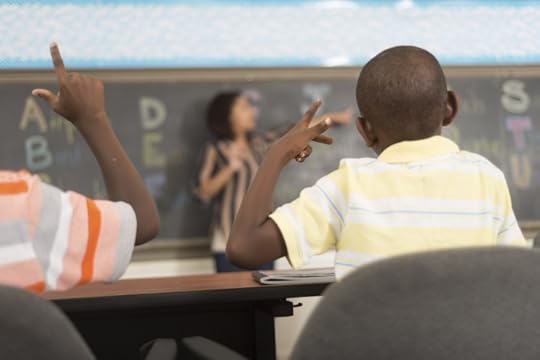 Learning sign language. © huePhotography via iStock.
Learning sign language. © huePhotography via iStock.As a non-society journal, there were some lean times early on, but JDSDE has gone on to become the preeminent scholarly journal in the field, at least according to several of the pioneers in the field. It has continued to grow in terms of breadth, quality, subscriptions, submissions, and impact factor. In 2014, it “spun-off” what OUP calls a microsite, Raising and Educating Deaf Children: Foundations for Policy, Practice, and Outcomes, a website that provides evidence-based information on…well…raising and educating deaf children…for parents, educators, policymakers, and others involved with deaf children and the Deaf community. Quarterly bulletins, often by JDSDE Board Members and authors, are accompanied by links providing free access to OUP publications as a public service of the Press. The first year saw the site viewed by over 18,000 unique visitors, and the audience is growing.
But we are now 20 years into this adventure, and it’s time for me to send the baby off into the world. Through the years, I have told my OUP Journals Editors that I wanted to step down before there was danger of my running the journal “into the ground,” as I have seen other editors stay in the chair too long. For years I’ve been looking for the person who I thought could take the journal to the next level and would be willing to put in the hours and energy necessary. Professor Susan Easterbrooks is now on board, after shadowing me for one year and serving as Co-Editor for another. In the coming weeks, I will pass the editorial mantle over to her, and for the first time watch JDSDE from a distance. It’s an interesting feeling.
When we started the journal, I sincerely (and naïvely) believed that in the Editor’s chair, I would be able to help the field become a more scholarly, empirically-based one. That has happened, as evidenced in the pages of the last 20 volumes of JDSDE, but I don’t think I had anything to do with it. The founding mothers and fathers of the journal wanted to provide a forum for the publication of good research, as well as high-quality theoretical and review papers, that could inform investigators, educators, and others about the strengths and needs of deaf children, the blossoming world of the Deaf community, the nature of signed languages, and, as described in one editorial, “all things deaf.” Toward that end, 20 years of effort by Associate Editors, Editorial Board members, ad hoc reviewers, and more than 1,000 authors has brought all of that to fruition.
A (deaf) colleague and friend, who is also an Editorial Board member, told me some years ago that if I gave up editing JDSDE, the journal would not survive. Well, the baby is all grown up, standing on its own feet, and neither he nor I need to worry about it anymore.
The post The baby is all grown up appeared first on OUPblog.

International Kissing Day and DNA
Another ‘Awareness Day’, International Kissing Day, is coming up on July 6. It might not seem obvious but kissing, like most subjects can now be easily linked to the science of DNA. Thus, there could be no more perfect opener for my Double Helix column, given the elegance and beauty of a kiss.
To start, there is the obvious biological link between kissing and DNA: propagation of the species. Kissing is not only pleasurable but seems to be a solid way to assess the quality and suitability of a mate. Philematologists, the scientists who study kissing, have accrued scientific evidence that we end relationships based on bad kisses and grow addictions to our partners thanks to good ones that act to douse our brains in dopamine.
We chose to participate in romantic kisses based on our assessment of DNA quality, part of that je ne sais quoi magic of attraction, and kissing creates unique DNA; when the genomes of two parents recombine, the result is a human being with DNA never-before seen on Earth.
The link between kissing and procreation has been known since time immemorial. Now there are some very modern updates to this classic story.
“To kiss” comes from the Old English cyssan, in turn from coss, “a kiss”. While the word kiss is ancient, the word DNA is modern and its use is significantly changing. A linguistic phenomenon is underfoot; DNA is moving beyond the laboratory and into the vernacular. We have adopted the metaphoric application of the term DNA, short for deoxyribonucleic acid, the building block of life, to mean ‘essence of’, ‘basis for’ or ‘soul of’. Social media is filled with “DNA compliments” like “Bless your DNA”. It is not uncommon to hear declarations like “It’s in my DNA to dance”. Porsche vehicle “Design DNA” includes the classic features of this luxury brand such as rear-end engine placement and Porsche’s immediately recognizable, aerodynamic shape.
Using this secondary definition of DNA, we could say, as humans, “it’s in our DNA to kiss”. We could also explain International Kissing Day by saying that its DNA is “to honour the humble kiss as an act of kindness and affection”.
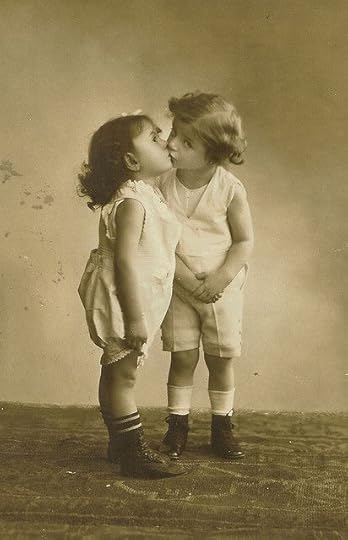 “The Kiss”, by ‘playingwithbrushes’. CC-BY-2.0 via Flickr.
“The Kiss”, by ‘playingwithbrushes’. CC-BY-2.0 via Flickr.There are also ‘six degrees of separation’ links as DNA continues to pervade modern culture. The company DNA 11 offers both DNA and Kiss Portraits. You can either see ‘you’ in these non-traditional wall hangings as a series of horizontal bands resembling ladders (your DNA chopped into pieces and run with electricity through a special kind of laboratory jelly) or as lips on canvas. The pop band Little Mix’s hit love song DNA from the 2012 album DNA mentioned the word kiss twice in the lyrics.
Getting into the realm of hard science, “Kiss a Ginger Day” formed in 2009 and each January 12th encourages the public to happily “kiss any and all red-heads”. Red hair is due to genetic mutations in the MC1R gene which is responsible for hair and skin pigmentation. Only lucky people with two ‘red-head’ copies (alleles) can claim this shower of attention.
Companies are emerging that are attempting to put the ultimate modern scientific spin on your chances of getting kissed. They are taking advantage of genetic profiling methods to find ideal partners. “Genetic matchmaking” is a concept pioneered by Claus Wedekind with his “sweaty t-shirt” study published in 1995. He famously showed that women find men more attractive if they have dissimilar immune system genes.
“Kissing DNA”, a phrase yet to be coined, is a recent discovery. Evidence that we are constantly trading DNA is mounting as researchers start to understand the dust cloud of genomes we all leave in our wake. We are constantly shedding cells and all of them contain our DNA. The inside of our mouths are particular rich in easily shed cells and this is why DNA-testing companies across the world rely on cheek swabs and spit samples for source material.
So, what happens when we kiss? Same thing occurs as when a swab is taken – we release our DNA. With a kiss it mingles. The DNA of a lover can be detected in your mouth up to an hour after the act. While for most this is just a pleasant by-product of intimacy, for victims of crime it could be a forensic method of putting assailants behind bars.
It’s not just your own, human DNA you share. You also trade in portions of your ‘second genome’, the community of microbes that colonize us, primarily in our guts.
If you are squeamish about ‘germs’, look away now. Our mouths harbour rich collections of invisible life. It is estimated that a kiss lasting longer than 10 seconds transfers 80 million living bacterial cells.
You get a dose of love-genes when your partner reciprocates the favour. Actually, 80 million is the tiniest fraction of the trillions of microbes in and on your body and diversifying your microbiome could have many beneficial effects.
Setting the world record for the longest kiss would now take a couple willing to exchange DNA for more than 2 days, 10 hours and 35 minutes. Perhaps this record will be exceeded in 2015 in honour of love.
It seems like we are being regaled with a ‘day’ in honour of everything, but kissing, from the platonic peck to the full out lip lock certainly seems an excellent reason to celebrate.
Featured image credit: Kissing, by maumau97. Public domain via Pixabay.
The post International Kissing Day and DNA appeared first on OUPblog.

July 1, 2015
Monthly etymology gleanings for June 2015
Several years ago, I wrote a post on the origin of the word frigate. The reason I embarked on that venture was explained in the post: I had run into what seemed to me a promising conjecture by Vittorio Pisani. As far as I could judge, his note had attracted no attention, and I felt it my duty to rectify the injustice. Last week I received a letter from Mr. Nikolai Tkachenko, a professional sailor and an enthusiastic student of marine vocabulary. His derivation of frigate seemed unconvincing to me, and I made no secret of my objections. However, he stands by his etymology and asked me to publish it, though I told him that I would add my thoughts on the subject. This is Mr. Tkachenko’s letter, which I have slightly edited for style and grammar:
“The noun fragata must be a past participle whose ultimate etymon was, obviously, fraga ‘strawberry’. A glance at the bird frigate, as it appears in Wikipedia, will show that this bird has a bright red throat pouch which bears a strong resemblance to the strawberry. The bird has been known to the speakers of Romance languages for at least two millennia and received its name thanks to the similarity between the pouch and the berry. Thus, fragata can be understood to mean ‘equipped with a strawberry’. These birds are characterized by high speed and maneuvering ability in flight; they are fearless in attack and tireless in the course of long air trips. When a thousand years ago light and fast warships were constructed for protecting merchant ships, the capture of pirate and enemy vessels, reconnaissance, and communication, they flew over the waves like the birds fragatas and were named fragata on account of the similarity between the vessel’s sailing qualities and the bird’s qualities in flight.”
My problems with this hypothesis are as follows.
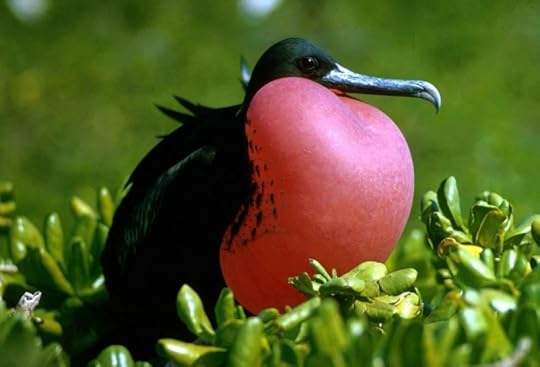 Here is the bird with a strawberry-looking throat pouch
Here is the bird with a strawberry-looking throat pouchI don’t quite understand from which verb the alleged participle was formed.
The word frigate, as applied to the ship, was first recorded in 1350; the homonymous name of the bird seems to have come into existence much later. Columbus (1492) referred to the bird as rabiforçado (Modern Spanish rabihorcado), that is, “fork(ed)-tail” rather than “strawberry throat.” The French did indeed call the bird la frégate, and the association was probably caused by the factors Mr. Tkachenko indicated (speed and ferocity), but we have no record of this name antedating 1667, so that, apparently, the bird was named after the ship, not the other way around.
As far as we can judge, the name of the ship was coined in Italy, and there it began with fre- not fra-. It seems that the only viable etymology of frigate should be sought in Italy.
As a matter of principle, I believe that any new suggestion on etymology should begin by showing that the previous attempts to explain the word’s origin failed, and I object to the use of adverbs like obviously in controversial matters.
The jarring word ajar
This was the title of my other old post, and our correspondent wonders whether Engl. ajar may have anything to do with Turkish açar, glossed by her as “open.” The Turkish words for “open” are açmak and açik (compare aç “empty”), while açar means “key.” Consequently, ajar an açar have as little in common as English bad and Persian bad. Moral: in dealing with etymology, beware of lookalikes. One cannot do without them, but they need a strict security check.
Foxglove and an old mistake
In 2010, I offered a post about etymologists’ war with flower names and close to the end of my story wrote England instead of Scotland, which made nonsense of the sentence. Some time later I received an ironic letter calling my attention to the mistake. I responded, all ashes and sackcloth, but failed to do the most natural thing: I did not ask my editor to correct the mistake (not a problem in a computer text!). Quite recently, somebody else has pointed to the same error. Now the right place name has been substituted for the wrong one. To this correspondent: Thank you for reading the blog, saying good words about that post, and not being too harsh on me.
On beds and graves
Here is one more letter: “Just read with interest your exploration of the word bed. The correlation with the meaning ‘grave’ suddenly gives a clearer sense (to my mind) to the expression make your bed and lie in it, although it’s hard to imagine that the phrase could go back so far… Thanks for the engaging read!” Surely, the idiom was never meant in this macabre sense. “–Will you walk out of the air, my lord? –Into my grave. –Indeed, that is out of the air.” We also know the joke about a passenger on board a ship asking the captain where his father died (–At sea.) –And your grandfather? (–At sea.) –Aren’t you afraid of being a sailor? –And where did your father die? (–In his bed.) –And your grandfather? (–Also in his bed.) –Aren’t you afraid to go to bed every night? In sum, as you make your bed, so you must lie on (in) it.
Nouns and adjectives
I have seemingly written (though I don’t remember where I did it) that wizard is a noun, not an adjective. But what about wizard prang, said about a really spectacular crash? One should distinguish between the terms adjective and attribute. For example, both floor and plank are nouns, but in the phrase floor plank, floor functions as an attribute, while in plank floor this role is played by plank. Compare flower garden and garden flower. Countless groups made up of two nouns can be reversed in the same way. Nouns will remain nouns (this is their morphology), but their syntactic functions may change. Despite the poverty of English morphology, one can occasionally make distinctions. Compare hero worship, hero’s worship, and heroic worship; girl voice and girlish voice; wool dress and woolen dress; and so forth. In the English-speaking world, people are taught that nouns in groups like hero worship become adjectives. This is misleading. Reference to attribute dispels all trouble. Incidentally, the same holds for verb and predicate.
 Grindel, a natural threshold or latch
Grindel, a natural threshold or latchGrendel and latches
This is another throwback into the past. While discussing the etymology of the word threshold, I wrote that of all the etymologies of the name Grendel I preferred the one that explained it as “latch.” Our correspondent drew my attention to Grindelwald, Switzerland, a village well-known to skiers and hikers. Indeed, there are quite a few place names of this type, and the word Grindel exists too. Most probably, the idea in giving the place this name was to emphasize that the village was the threshold beyond which the mountains begin.
The suffix -el
Question: “If -el is a suffix in barrel, what about tunnel and vessel?” The same! Tunnel was borrowed into Middle English from French; some of its former meanings are no longer current. The etymon is Old French tonel “a small cask, vat, tun.” From a historical point of view, a tunnel is a small cask, a casket, as it were. Vessel is also a loan from Romance, “a small vase.” The late Latin word was vascellum.
Splitters win
Every time I object to a construction like to be or to not be someone takes me to task. I am a meek person, not a bully, and can be easily cowed. Congratulations to my opponents! One of the three definitions of throttle in Merriam-Webster online is ‘to not allow (something) to grow or develop’. Acceptance in Springfield, MA is like being received at Lady Windermere’s. To not agree with them would be blasphemy. I intend to no longer live in what good writers call self-absorbed discontent. Let her rip, let them split.
Image credit: (1) Fregata. CC0 via Pixabay. (2) Grindel, Switzerland. CC0 via Wikimedia Commons.
The post Monthly etymology gleanings for June 2015 appeared first on OUPblog.

Oxford University Press's Blog
- Oxford University Press's profile
- 238 followers



